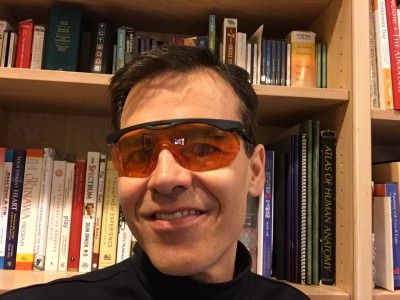#095 6 Ways to Stop Feeling Hungry All the Time
April 20th, 2015 by Dr. John DayPodcast: Play in new window | Download
Subscribe: RSS
6 Ways to Stop Feeling Hungry All the Time
The holidays are the worst time of the year for Josie. Josie is just 16 and all she can think about is food. She is obsessed with food and is hungry all of the time. Regardless of how much she eats, she is always hungry.
According to her mother, “Ever ingredient is meticulously measured and the calories counted. When she was younger, screaming tantrums would begin if the clock ticked past the allotted serving time.”
To save her from overeating, her mother shares, “We pile up the meal on a small dish so it looks fuller. We cut food in half and tell her it’s twice as much. We keep empty raisin boxes and fill them with half the number they’d normally contain so she can have an extra box. We always keep back a bit of her meal so that if there’s a dropped spoon disaster, and three peas go on the floor, then three peas get replaced.”
Josie has a rare genetic condition, called Prader-Willi Syndrome, which causes her hunger hormone, ghrelin, to be extremely high. Unless people suffering from this condition are physically restrained from eating, they will literally eat themselves to death. If left unchecked, Prayer-Willi patients typically die young from obesity related complications.
Can the same thing happen to us? Can our hunger hormones also get so far out of the normal range that we also feel hungry all the time? In this article I will share with you 6 ways to stop feeling hungry all the time.
The Hunger Hormones
Before we discuss how to stop feeling hungry all the time, let me first introduce the “hunger hormones” and discuss the reasons why we feel hungry. Below are the main hunger hormone players:
1. Ghrelin
Ghrelin, also called the “Ghrelin Gremlin,” is the one to fear the most. Another easy way to remember the roles of ghrelin and leptin is that ghrelin “grows” your appetite whereas leptin “lowers” your appetite. Ghrelin levels are extremely high with the Prader-Willi Syndrome.
When there is nothing in our stomachs, the hormone ghrelin is released. On the other hand, when our stomachs are full then ghrelin secretion stops. Once released, ghrelin acts on receptors in the brain to make us feel hungry.
The frustrating thing is that ghrelin not only makes us feel hungry but also activates the “reward center” of our brains. Activating the reward center of our brains makes us crave the addictive or “comfort foods” like pizza or chocolate chip cookies.
Now that we understanding how ghrelin works, one obvious way to suppress ghrelin production is to fill our stomachs with water, fiber, or other low calorically dense foods at meal times. If we can “stretch” our stomachs with a big salad and a tall glass of water then perhaps we can quickly shut down the body’s production of ghrelin.
2. Leptin
Leptin is another hunger hormone. Leptin is released from the fat cells when they are “full” to signal to the brain to stop eating.
Leptin has the opposite effect of ghrelin. Thus, for most people, letpin is a good thing if the goal is to stop feeling hungry all the time. To help remember the effects of leptin just remember “lucky leptin.”
A young boy’s medical case, we’ll refer to him as “T,” was recently described in the most prestigious medical journal, The New England Journal of Medicine. “T” is two years old and lives in the country of Turkey. As with Josie, “T” is also hungry all of the time. He ravenously devours any food he can get. He never feels full.
“T” has a rare genetic condition where his brain cannot detect leptin. While “T’s” height is just a litter bit taller than average, at the young age of just 2 he weighs 67 pounds! Unlike Josie, T’s parents have not restrained him from eating.
“T’s” condition is something that has been well described in adults. This condition is called “Leptin Resistance.” With leptin resistance, even though leptin levels are high the brain cannot detect leptin.
The purpose of leptin is to prevent us from gaining weight. The problem is that even though leptin levels are high in obese people, the brain never “registers” the leptin. While leptin resistance in adults is not as severe as with “T,” leptin resistance may play a significant role in the worldwide obesity crisis.
Researchers are just starting to learn why obese people’s brains do not register the leptin signaling that they are “full.” New research suggests that we can block the effects of leptin from eating a diet high in sugar and simple carbohydrates. These simple carbs raise our triglyceride levels which has been shown to block leptin signaling to the brain.
Of course, the obvious way to help our brains to sense leptin and stop feeling hungry all the time is to minimize sugar and simple carbohydrates in our diets.
3. Insulin
Insulin is a hormone released by the pancreas. Insulin is released when blood sugar levels rise. The main effect of insulin is to cause us to store fat.
A diabetic patient recently told me, “as soon as I went on insulin I gained 10 pounds!” This is not unusual. If you talk with many people with diabetes they will often tell you the same thing.
A high sugar meal, like bread, pasta, or breakfast cereals, will cause a high spike in your blood sugar levels. When this happens, the pancreas releases insulin causing the extra sugar to be stored as body fat. Once the blood sugar drops you are hungry and the cycle begins all over again.
A simple way to prevent hypoglycemia from making you hungry is to eat foods that don’t spike your blood sugar. Minimizing or avoiding sugar and simple carbohydrates will keep your blood sugar levels stabilized.
4. Cortisol
Have you or a loved one ever taken a short course of prednisone or another steroid? Were you always hungry? Did you gain 5 to 10 pounds from just a week of taking prednisone or another steroid?
Cortisol is the body’s steroid hormone. Cortisol is released from our adrenal glands. When we are sleep deprived or chronically stressed, cortisol levels are high. As long as cortisol levels remain high our appetite will remain high as well.
5. Neuropeptide Y
Neuropeptide Y is a brain neurotransmitter and is also considered by many to also be a “hunger hormone.” Neuropeptide Y is a powerful brain chemical that compels us to eat.
In a classic study, researchers in 1985 injected male rats with neuropeptide Y. Within just minutes of the injection, male rats became obsessed with food and lost all interest in sex. Even though a willing sexual mate was readily available, these male rats, under the influence of neuropeptide Y, craved rat chow more than sex.
Studies show that neuropeptide Y is released in response to stress as well as a high sugar, high fat diet. Interestingly, intermittent fasting has been shown to lower neuropeptide Y levels.
Clearly, if we want to stop feeling hungry all the time, we also need to keep neuropeptide Y levels down. The best way to do this is to minimize or avoid unhealthy fats and sugar, manage stress, and, under the direction of your physician, consider intermittent fasting.
I Have a “Double Dose” of the Fat Gene
I have had my genome analyzed and I have two copies of a variant of the FTO gene which is also known as the “Fat Gene.” Having two copies of the “Fat Gene” (one from my mother and one from my father) means that my ghrelin levels are genetically programmed to be high.
This means, that for those of us with two copies of this gene, we don’t feel full when we eat. Studies show that most people in the U.S. with a “double dose” of the Fat Gene are obese.
While eating the Standard American Diet (SAD), I was overweight and yet was always hungry. Since changing my lifestyle, my weight has dropped 30 pounds and I have maintained this weight loss now for more than 3 years. While a healthy lifestyle has helped me to control my hunger and ghrelin levels, if I am not careful I can quickly become very hungry very fast.
Despite having genetically high levels of ghrelin, at least I can feel fortunate that I don’t have the same constant hunger pains that someone suffering from the Prader-Willi Syndrome might have.
6 Ways to Stop Feeling Hungry All the Time
Now that we understand the brain chemistry of hunger, we can now “hack” our hunger to keep ghrelin, cortisol, insulin, and neuropeptide Y levels low and allow our brains to shut down the hunger signals by being able to sense leptin. Here are my 6 very best ways to stop feeling hungry all the time.

Ghrelin Release from the Stomach
1. Fill Your Stomach to Stop Ghrelin Release
If you want to keep the “ghrelin gremlins” at bay, stretch your stomach with low caloric density food. In other words, drinking water with your meals, eating high fiber foods, or just filling your stomach with lots of vegetables can fill your stomach to suppress ghrelin and keep you at a healthy weight.
In contrast, very caloric dense food, like a piece of cake or a piece of candy, doesn’t fill your stomach. Because the stomach is not stretched from these calorically dense foods, ghrelin levels remain high. As long as ghrelin levels remain high, your brain will drive you to eat more.
When you feel hunger coming on, and it is not yet time to eat, reach for a bowl or bag of fresh vegetables and a glass of water to drive the “ghrelin gremlins” away.
2. Minimize Sugar and Simple Carbs
“Lucky leptin” is the signal that comes from our fat cells and tells our brains we have had enough food. This is the hormone that is supposed to keep us at a healthy weight.
The problem is that most obese people are “leptin resistant.” Unfortunately, studies show that sugar and simple carbs block the effect of leptin on our brains. In addition, sugar and simple carbs increase insulin and neuropeptide Y release.
In order to prevent leptin resistance and keep insulin and neuropeptide Y levels down, minimize sugars and simple carbs. I have found that for most of my patients, if they can just minimize or eliminate sugar and simple carbs, their weight quickly normalizes.
3. Get At Least 7 Hours of Restorative Sleep
Sleep is probably the most under appreciated weight loss strategy. Besides the obvious that we are not eating when we are sleeping, getting enough sleep at night keeps ghrelin levels low and leptin levels high. This is exactly the right combination which will help us to stop feeling hungry all the time.
In contrast, sleep deprivation increases cortisol and neuropeptide Y levels as well. With all of these hunger hormones working against us, sleep deprivation makes it exceedingly difficult to maintain a healthy weight.
Don’t worry about going to bed hungry as sleep quickly raises leptin levels to prevent hunger from awakening you at night. If hunger is waking you up at night then there is a good chance you are “leptin resistant.”
4. Practice Stress Management Each Day
Along with sleep, another under appreciated way to stop feeling hungry all the time is to manage stress. When we are feeling stressed out, studies show that ghrelin, cortisol, and neuropeptide Y levels go up while leptin levels fall. Once again, this is the perfect storm for feeling hungry all the time and gaining weight.
As chronic stress and weight gain go hand-in-hand, is it any wonder that yoga and meditation have both been shown to be possible weight loss options? The key point here is to find what helps you to “de-stress” and do that each day.
5. Minimize or Avoid Unhealthy Fats
As a diet high in the unhealthy fats has been shown to induce neuropeptide Y, the goal is to minimize or avoid the unhealthy fats. The main source of unhealthy fats in our diet is from processed foods, fast foods, and most restaurant foods.
6. Intermittent Fasting
It seems counter intuitive to fast in order to help control hunger. However, if you are healthy, intermittent fasting for periods as short as 12 hours, has been shown to have beneficial effects. For example, intermittent fasting may help with leptin resistance as it lowers triglyceride levels. In addition, fasting lowers neuropeptide Y levels. If you are interested in intermittent fasting, please discuss this with your physician first.
Are you always hungry? What has helped you to stop feeling hungry all the time?




















 hey also wanted to understand what were the most important factors to successfully maintaining a healthy weight.
hey also wanted to understand what were the most important factors to successfully maintaining a healthy weight. I realize that in our hectic lives it can be very difficult to carve out an hour each day to exercise. For me, this is why I use my treadmill and bike desks everyday (see photos). This allows me to multitask so that I can both maintain a healthy weight and get my work done simultaneously.
I realize that in our hectic lives it can be very difficult to carve out an hour each day to exercise. For me, this is why I use my treadmill and bike desks everyday (see photos). This allows me to multitask so that I can both maintain a healthy weight and get my work done simultaneously.











 adopts her.”
adopts her.” What are the lessons of this story?
What are the lessons of this story? For me, I need time to write articles like this or the book we are working on with Harper Collins. To help me meet all of my needs, I have a treadmill desk as well as a bike desk in an unused room of our basement as seen here.
For me, I need time to write articles like this or the book we are working on with Harper Collins. To help me meet all of my needs, I have a treadmill desk as well as a bike desk in an unused room of our basement as seen here.